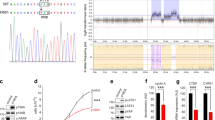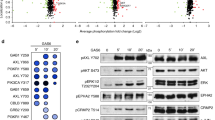Abstract
Focal adhesion kinase (pp125FAK) is present at sites of cell/extracellular matrix adhesion and has been implicated in the control of cell behaviour. In particular, as a key component of integrin-stimulated signal transduction pathways, pp125FAK is involved in cellular processes such as spreading, motility, growth and survival. In addition, a number of reports have indicated that pp125FAK may be up-regulated in human tumour cells of diverse origin, and consequently, a role has been proposed for pp125FAK in the development of invasive cancers. However, to date the mechanisms that lead to elevated pp125FAK expression in tumour cells have not been determined. Here we used in situ hybridization to confirm chromosome 8q as the genomic location of the human fak gene and report that elevation of pp125FAK protein in cell lines derived from invasive squamous cell carcinomas is accompanied by gains in copy number of the fak gene in all cases examined. In addition, we observed increased fak copy number in frozen sections of squamous cell carcinomas. Furthermore, increased dosage of the fak gene was also observed in many cell lines derived from human tumours of lung, breast and colon, including two cell lines Calu3 and HT29, in which fak was amplified. In addition, in an in vitro model for human colon cancer progression there was a copy number gain of the fak gene during conversion from adenoma to carcinoma, which was associated with increased pp125FAK protein expression. Thus, we show for the first time that many cell lines derived from invasive epithelial tumours have increased dosage of the fak gene, which may contribute to the elevated protein expression commonly observed. Although other genes near the fak locus are co-amplified or increased in copy number, including the proto-oncogene c-myc, the biological properties of pp125FAK in controlling the growth, survival and invasiveness of tumour cells, suggest that it may contribute to the selection pressure for maintaining increased dosage of the region of chromosome 8q that encodes these genes.
This is a preview of subscription content, access via your institution
Access options
Subscribe to this journal
Receive 50 print issues and online access
$259.00 per year
only $5.18 per issue
Buy this article
- Purchase on Springer Link
- Instant access to full article PDF
Prices may be subject to local taxes which are calculated during checkout




Similar content being viewed by others
References
Akasaka T, van Leeuwen RL, Yoshinaga IG, Mihm Jr MC and Byers HR. . 1995 J. Invest. Dermatol. 105: 104–108.
Avraham S, London R, Fu Y, Ota S, Hiregowdara D, Li J, Jiang S, Pasztor LM, White RA, Groopman JE and Avraham P. . 1995 J. Biol. Chem. 270: 27742–27751.
Brunton VG, Ozanne BW, Paraskeva C and Frame MC. . 1997 Oncogene 14: 283–293.
Cary LA, Chang JF and Guan JL. . 1996 J. Cell. Sci. 109: 1787–1794.
Chen HC, Appeddu PA, Parsons JT, Hildebrand JD, Schaller MD and Guan JL. . 1995 J. Biol. Chem. 270: 16995–16999.
Chen HC and Guan JL. . 1994 Proc. Natl. Acad. Sci. USA 91: 10148–10152.
Cobb BS, Schaller MD, Leu TH and Parsons JT. . 1994 Mol. Cell. Biol. 14: 147–155.
Crouch DH, Fincham VJ and Frame MC. . 1996 Oncogene 12: 2689–2696.
Edington KG, Loughran OP, Berry IJ and Parkinson EK. . 1995 Mol. Carcinog. 13: 254–265.
Fiedorek Jr FT and Kay ES. . 1995 Mamm Genome 6: 123–126.
Fincham VJ, Wyke JA and Frame MC. . 1995 Oncogene 10: 2247–2252.
Fincham VJ and Frame MC. . 1998 EMBO J. 17: 81–92.
Frisch SM, Vuori K, Ruoslahti E and Chan-Hui PY. . 1996 J. Cell. Biol. 134: 793–799.
Gilmore AP and Romer LH. . 1996 Mol. Biol. Cell. 7: 1209–1224.
Harte MT, Hildebrand JD, Burnham MR, Bouton AH and Parsons JT. . 1996 J. Biol. Chem. 271: 13649–13655.
Hildebrand JD, Schaller MD and Parsons JT. . 1995 Mol. Biol. Cell. 6: 637–647.
Hungerford JE, Compton MT, Matter ML, Hoffstrom BG and Otey CA. . 1996 J. Cell. Biol. 135: 1383–1390.
Ilic D, Furuta Y, Kanazawa S, Takeda N, Sobue K, Nakatsuji N, Nomura S, Fujimoto J, Okada M and Yamamoto T. . 1995 Nature 377: 539–544.
Ilic D, Kanazawa S, Furuta Y, Yamamoto T and Aizawa S. . 1996 Exp. Cell. Res. 222: 298–303.
Kharbanda S, Saleem A, Yuan Z, Emoto Y, Prasad KV and Kufe D. . 1995 Proc. Natl. Acad. Sci. USA 92: 6132–6136.
Lev S, Moreno H, Martinez R, Canoll P, Peles E, Musacchio JM, Plowman GD, Rudy B and Schlessinger J. . 1995 Nature 376: 737–745.
Manning AM, Williams AC, Game SM and Paraskeva C. . 1991 Oncogene 6: 1471–1476.
McCormack SJ, Brazinski SE, Moore Jr JL, Werness BA and Goldstein DJ. . 1997 Oncogene 15: 265–274.
Murphy DS, McHardy P, Coutts J, Mallon EA, George WD, Kaye SB, Brown R and Keith WN. . 1995 Int. J. Cancer 64: 18–26.
Owens LV, Xu L, Craven RJ, Dent GA, Weiner TM, Kornberg L, Liu ET and Cance WG. . 1995 Cancer Res. 55: 2752–2755.
Parkinson EK, Hume WJ and Potten CS. . 1986 Int. J. Radiat. Biol. Relat. Stud. Phys. Chem. Med. 50: 717–726.
Polte TR and Hanks SK. . 1995 Proc. Natl. Acad. Sci. USA 92: 10678–10682.
Rheinwald JG and Beckett MA. . 1981 Cancer Res. 41: 1657–1663.
Richardson A, Malik RK, Hildebrand JD and Parsons JT. . 1997 Mol. Cell. Biol. 17: 6906–6914.
Richardson A and Parsons JT. . 1995 Bioessays 17: 229–236.
Richardson A and Parsons T. . 1996 Nature 380: 538–540.
Sasaki H, Nagura K, Ishino M, Tobioka H, Kotani K and Sasaki T. . 1995 J. Biol. Chem. 270: 21206–21219.
Schaller MD and Parsons JT. . 1994 Curr. Opin. Cell. Biol. 6: 705–710.
Schlaepfer DD, Hanks SK, Hunter T and van der Geer P. . 1994 Nature 372: 786–791.
Sieg DJ, Ilic D, Jones KC, Damsky CH, Hunter T and Schlaepfer DD. . 1998 EMBO J. 17: 5933–5947.
Tachibana K, Sato T, D'Avirro N and Morimoto C. . 1995 J. Exp. Med. 182: 1089–1099.
Tremblay L, Hauck W, Aprikian AG, Begin LR, Chapdelaine A and Chevalier S. . 1996 Int. J. Cancer. 68: 164–171.
Turner CE and Miller JT. . 1994 J. Cell. Sci. 107: 1583–1591.
Wen LP, Fahrni JA, Troie S, Guan JL, Orth K and Rosen GD. . 1997 J. Biol. Chem. 272: 26056–26061.
Williams AC, Browne SJ, Yeudal WA, Paterson IC, Marshall CJ, Lane DP and Paraskeva C. . 1993 Oncogene 8: 3063–3072.
Williams AC, Harper SJ and Paraskeva C. . 1990 Cancer Res. 50: 4724–4730.
Xing Z, Chen HC, Nowlen JK, Taylor SJ, Shalloway D and Guan JL. . 1994 Mol. Biol. Cell. 5: 413–421.
Xu LH, Owens LV, Sturge GC, Yang X, Liu ET, Craven RJ and Cance WG. . 1996 Cell. Growth Differ. 7: 413–418.
Acknowledgements
We thank Adam Hurlstone for his help with PAC isolation, members of Nicol Keith's lab for help with FISH analysis, David Gillespie for the anti-c-Myc antibody, Alan Richardson and Tom Parsons for pp125FAK cDNA and John Wyke for reading the manuscript. This work was supported by the Cancer Research Campaign (UK). V Brunton and D Owens were supported by the Medical Research Council (UK).
Author information
Authors and Affiliations
Rights and permissions
About this article
Cite this article
Agochiya, M., Brunton, V., Owens, D. et al. Increased dosage and amplification of the focal adhesion kinase gene in human cancer cells. Oncogene 18, 5646–5653 (1999). https://doi.org/10.1038/sj.onc.1202957
Received:
Revised:
Accepted:
Published:
Issue Date:
DOI: https://doi.org/10.1038/sj.onc.1202957
Keywords
This article is cited by
-
The amide derivative of anticopalic acid induces non-apoptotic cell death in triple-negative breast cancer cells by inhibiting FAK activation
Scientific Reports (2023)
-
FAK regulates IL-33 expression by controlling chromatin accessibility at c-Jun motifs
Scientific Reports (2021)
-
Targeting FAK in anticancer combination therapies
Nature Reviews Cancer (2021)
-
BRD4 modulates vulnerability of triple-negative breast cancer to targeting of integrin-dependent signaling pathways
Cellular Oncology (2020)
-
Focal adhesion kinase (FAK) activation by estrogens involves GPER in triple-negative breast cancer cells
Journal of Experimental & Clinical Cancer Research (2019)



